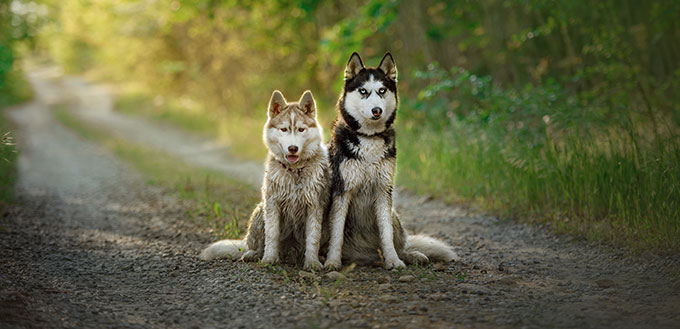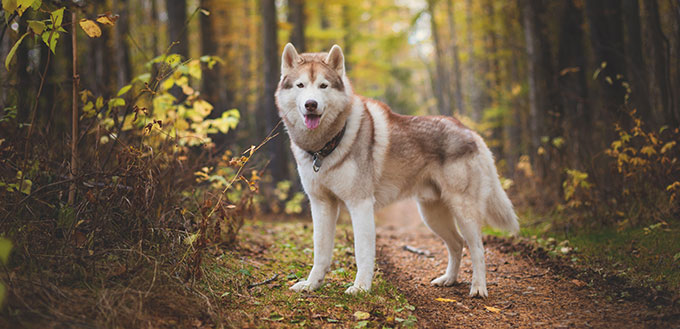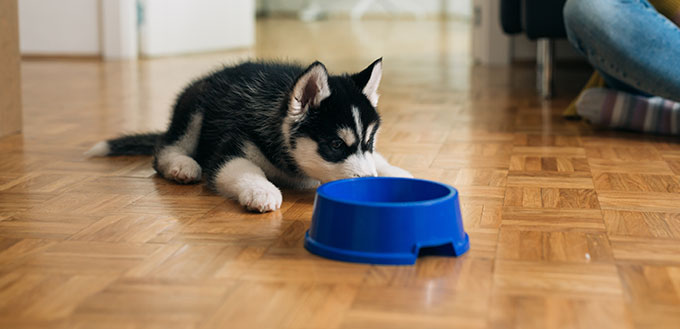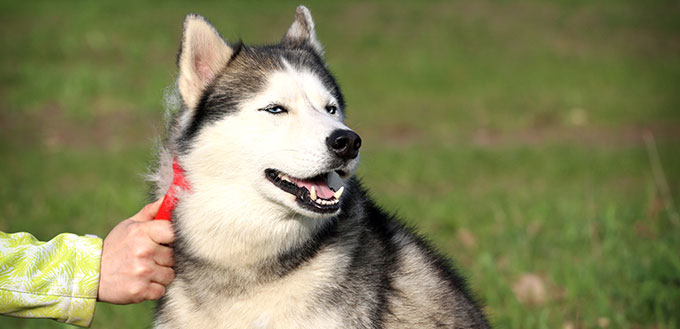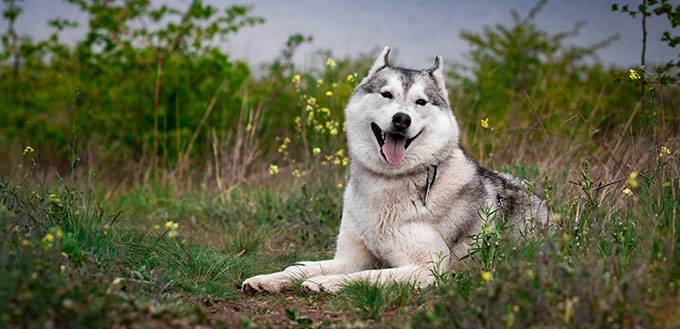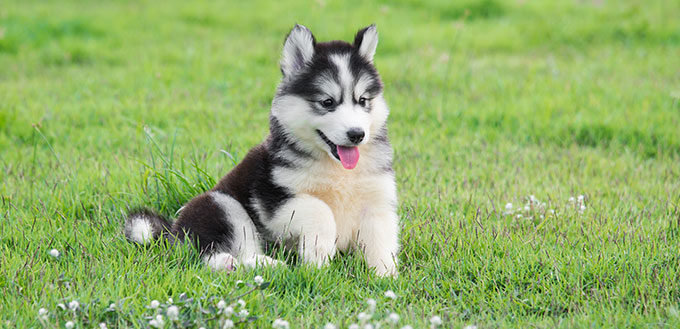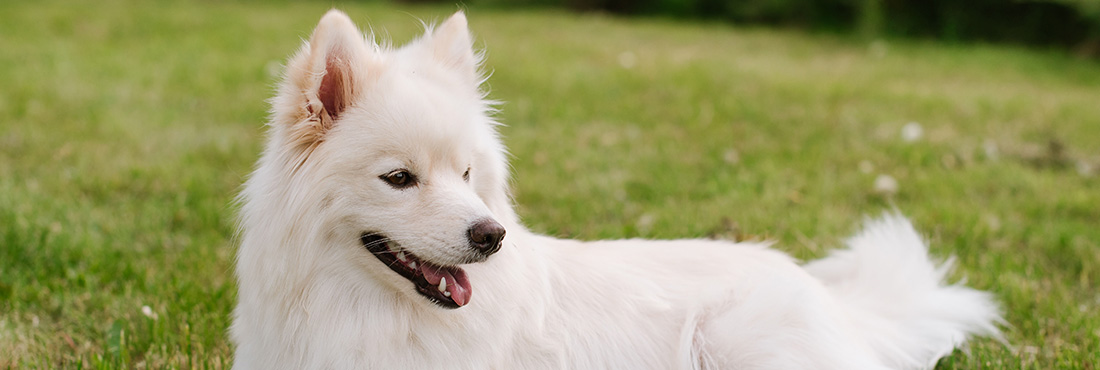The Siberian Husky is an athletic, hard-working, graceful, and fastidious sled-dog breed that has seemingly limitless energy and a constant eagerness to please. This breathtakingly beautiful breed is extremely friendly if not a little bit mischievous, so don’t let those fierce, piercing blue eyes fool you, they may look mean but they can be incredibly gentle and make a fantastic family dog. They’re wonderfully suited to an active household and make a fantastic working companion, and if you raise a husky right, you are guaranteed a best friend for life. This comprehensive guide is filled with all of the Siberian Husky dog breed information you should need, to hopefully help you to prepare properly, should you be thinking of getting a Siberian Husky in the future.
Breed Overview
| Dog Breed Group | Height | Weight | Life Expectancy | Energy Level |
|---|---|---|---|---|
| Working Dog | 20-23 inches | 35-60 pounds | 12-15 years | High |
History of the Siberian Husky
The Siberian husky breed originated from Northeast Asia, specifically Siberia, and was specifically developed and bred to be sled dogs by the Chukchi people. The church key or tribe of Siberian Nomads huskies as a faster mode of transportation as well as being loved as a family dog. DNA tests have confirmed that huskies are amongst the oldest dog breeds, owing to the fact that they were perfected early and have done their job so well over the years that there has been no need to change the breed in any way.
Siberian Huskies were imported to North America by a fur trader named William Goosak to Alaska in 1908 and were used for transport during the Gold Rush Upon their arrival, the people of Nome decided to nickname these smaller dogs “Siberian Rats”, as they had only had experience with Malamutes up until that time.
Shortly after, in WWII they were recruited alongside Malamutes for the U.S. Army and became the Arctic Search and Rescue Unit, specifically to search areas that were inaccessible with motorized equipment. These Siberians were also taught to jump from planes in order to bring supplies to airmen that had been downed and had become isolated.
Though they were most notably used in Alaska in 1925 in order to transport medicine to the town of Nome who was in the throes of a deadly diphtheria epidemic; the use of 20 sled dog teams, coordinated by the well-known “musher” Leonhard Seppalato, transferring antitoxins over 674 miles in six days saved over 10,000 lives.
In 1930 the American Kennel Club recognized the Siberian husky as a breed of its own, and in order for a dog to the class as a Siberian Husky, it must meet highly specific breed criteria. Furthermore, the Siberian Husky Club of America was founded in 1938, followed by the Canadian Kennel Club recognizing the Husky in 1939. Siberian Huskies are now the 12th most popular dog breed in the United States.
A Few More Words About Siberian Huskies
Siberian Huskies, when well looked after, can live a rather long life, with an average life span of 12-15, with the oldest husky in the world rumored to have lived 18! They may be argumentative and more than a little cheeky at times, but they are sweet and loveable all the same, and can’t half have a conversation with you when the mood strikes them!
It is worth knowing, if you’re considering a Husky for a pet, that they are a high maintenance breed. Though their grooming requirements are quite simple, the fact that they are working dogs means they will require plenty of stimulation, both mental and physical, to keep them from getting bored. They are also quite demanding of your undivided attention, so you should be ready to play when they say play, and fuss when they say fuss.
The “zoomies” are also a very common trope with Siberians, so it’s extremely likely that just when everyone is settled for the evening, your Sibe could decide to shake things up by charging full speed around the living room for a few laps, before getting comfortable again.
Breed Highlights
- A naturally curious breed that needs to be watched so that they don’t escape and get lost.
- Siberian Huskies were bred to be friendly companion dogs and to be able to work well in a team, therefore aggression was mostly bred out of them.
- Siberian Huskies have a tendency to be extremely vocal and like to howel, but they don’t often bark.
- This is a highly destructive breed if not trained properly, and can cause large amounts of damage in a short space of time, including digging up gardens.
- Often adopted or bought from their beauty, many people fail to research the Siberian Husky breed properly and are consequently unable to handle their quirks and temperament leading to many Huskies ending up in a shelter.
- Their high prey drive can sometimes make Siberian Huskies troublesome around small animals, because of this they are best kept on the lead at all times.
Breed Appearance
Seeing as the Siberian Husky is often bought because of its appearance, it seems only right that you know exactly what is expected of a Husky when it comes to their looks. Siberian Huskies are beautiful, soft, fluffy, and can look a little bit intense (what with the piercing blue eyes and all), and though they can come in quite a wide variety of colors, their shape is expected to look the same at all times, and only certain colors are deemed acceptable for this d by the American Kennel Club.
Size
| Measurement | Males | Females |
|---|---|---|
| Height (to top of head) | 27.5-31 inches | 26-30 inches |
| Withers Height | 21-23.5 inches | 20-22 inches |
| Length | 30-34.5 inches | 30-34.5 inches |
| Weight | 45-65 pounds | 35-50 pounds |
Coat
| Feature | Description |
|---|---|
| Coat Color | As recognized by the AKC: Black and white Red and white Agouti and white Grey and white Sable and white White |
| Length | Medium length |
| Texture | Dense and wave undercoat Thick, straight overcoat of guard hairs. |
| Pattern | Most commonly they are a “splash” pattern, meaning that the colors of their coat are often large bold markings, though some can have a “diluted” appearance, meaning their fur pattern is blended, and the markings less defined. |
| Resistance | Weather-resistant to help with working in cold temperatures. |
| Thickness | Double layered, the dense undercoat protects against extremely low temperatures. |
Face
| Feature | Description |
|---|---|
| Expression | Keen, but friendly, interested and mischievous |
| Eyes | Almond-shaped Clear blue Brown Mixed of one brown, one blue Parti-colored between the two |
| Muzzle | Medium Length Medium width Tapers slightly towards the nose Neither pointed nor square |
| Ears | Medium-sized Close-fitting Triangular shape with rounded tips Set high on the head Strongly erect |
| Skull | Medium-sized In proportion with the body Slightly rounded Tapers from the widest point to the eyes |
| Additional Features | Many Siberian Huskies have markings above their eyes that can give them an angry or intense expression (especially if combined with blue eyes). |
Build
| Feature | Description |
|---|---|
| Overall Size | Medium-sized breed |
| Stance | Proud |
| Neck | Medium-length and arched |
| Forequarters | Shoulders set well back Front legs straight and moderately spaced Front feet are oval-shaped and medium-sized with fur between the toes |
| Hindquarters | Back legs moderately spaced and parallel Muscular and powerful thighs |
| Tail | Fox-brush shaped Curves over the back when the dog is at attention Trailed when the dog is relaxed |
| Gait | Smooth and effortless as well as a light on their feet |
Interesting Siberian Husky Facts
- In 1910 All Alaska Sweepstakes, a team of Siberian Huskies owned by Leonhard Seppala took first place, and Huskies still run the Sweepstake today.
- The soft warm bodies were used like dog-shaped blankets with Chukchi children.
- One of the Huskies from the diphtheria Epidemic named Balto (Seppala’s lead dog) is immortalized in a bronze statue in New York’s Central Park.
- The Siberian Husky Club briefly considered changing the breed’s name to the Chukchi Indian Dog in the 1990s.
- Between 1938-1991 the Siberian Husky was known as the Arctic Husky.
- Huskies are still used in sled races today.
The Siberian Husky Dog Breed Personality
Bringing up a Siberian Husky is not always an easy job; they are boisterous and playful, but can also be stubborn and argumentative. Knowing the ins and outs of a Siberian Husky’s temperament can help you to understand your dog far better. When it comes to getting a dog of any dog breed, learning about the temperament, behavioral traits and personality traits of that particular breed are essential to figuring out how best to raise them and what you may expect of them once you get them home.
Temperament
Siberian Huskies don’t only have an excessive amount of energy, meaning they are in almost constant need of exercise, but they also have what you are considered to be excessive personalities.
Endearing and loveable as they are, Siberian Huskies love to soak up attention and are not afraid to argue back if they don’t fancy doing something. Quite literally, a Siberian Husky will shout and grumble at you and can even have a full conversation should they decide they don’t want to do something, much to the entertainment of everybody else in the room.
Though they can be very vocal and have a particular fondness for howling, they are not barking dogs and will not alert bark if somebody enters the property. In fact, the breeding process for Siberian Huskies aimed to eliminate aggression in order to ensure that they could work well together when used as sled dogs, this is also why huskies are extremely playful, as it was this playful nature that helped to keep the peace when they had to work in such close quarters with one another.
Entertainment
Owing to their sharp wits and high IQ, Siberian Huskies require plenty of entertainment throughout the day to keep them from getting bored. If a Siberian Husky gets bored you run the risk of them becoming destructive as a way to pass the time, and if they decide to wreck something they’ll put everything they’ve got into doing it! So here’s a few top activities you can give them to keep them from ripping your house up:
Walks: Siberian Huskies have a lot of pent-up energy that needs exercising out of them. Be sure to take your canine friend for a couple of long walks a day to keep the zoomies at bay.
Training: Training is the perfect combination of physical exertion and mental stimulation to easily help your Siberian Husky work through that excess energy.
Dog Sports: Huskies are perfectly suited to dog sports as the activity level can match their energy levels as well as the breed having a naturally high endurance meaning they can go for a lot longer than many other dog breeds.
Around Children
Not only does the Siberian Husky’s playful good nature and affectionate personality make them great with children, but they generally do well with other people in general, making them a fantastic family pet That’s also why a Husky wouldn’t make a great guard dog, because you could expect that they would rather lick an intruder to death as opposed to frightening them away.
Though the Siberian Husky’s natural affinity towards people is a big part of their charm and gives them a fantastic opportunity to show how gentle they can be, it is always worth noting that young children should not be left alone with any dog breed, not just huskies.
Around Other Animals
Though huskies do have a high prey drive, if they are socialized properly whilst they are young this won’t be a problem. The most troublesome part about having a Siberian husky around other animals is that they are extremely playful, especially at an early age and some animals, particularly smaller ones like a cat, may not take kindly to having a Husky in their face insisting on their interaction. Though it is worth noting that because they were bred to get along with other huskies in constant close quarters when it came to being sled dogs, they typically get on very well with other dogs, so long as the other dog is sociable as well.
Contrary to what many may believe, considering the husky is thought to be wolf-like and therefore a loner, huskies and malamutes alike are dog breeds that ideally require human or canine companionship.
Quick Personality Facts
- They are a very vocal breed and have a tendency to howl loudly; multiple Siberians can set each other off.
- Siberians are an incredibly social breed that requires the support of companionship with either a large family or fellow pets.
- They love to play and splash around in the water during hot weather, however, they are not swimmers and should not be put in a pool.
- Siberians can be neurotic and stubborn making them difficult to train, as well as being argumentative.
- They are extremely affectionate and loving, as well as being very playful, therefore wanting a lot of attention and playtime.
Siberian Husky Care
Caring for Siberian Husky Means knowing the best way to train them, what foods are best suited for them, if they have any special dietary requirements, and how to care for their coats as well. They are not an overly complicated breed to take care of, and fortunately, they’re not too fussy when it comes to food and drink, however ensuring that they are getting the right diet for their breed will go a long way to keeping them fighting fit. So here are some tips and tricks on some of the key aspects of pet care for a Husky, as well as raising a Siberian husky puppy.
Training
The most important thing to know when it comes to training your canine pal is that Siberian huskies, though they may love you very much, do not care all that much about pleasing you and are quite happy to do things however they see fit. As a result, Siberian Huskies can be quite hard-headed and argumentative when it comes to simple training, the more complicated the training, the more difficult it can be. The one thing you can rely on is that they are an extremely intelligent breed and so once you are able to work around their attitude problem they can grasp a new instruction very well.
You will need to rely heavily on positive reinforcement, lots of treats! You must also remember that Siberian Huskies, being a social breed, will want and require plenty of socialization whilst they are still young. Like anything, training is about repetition; once your puppy is able to start understanding a command, they are more likely to fall in line and start behaving during training sessions. Though be wary you don’t catch them on a bad day or you could find yourself in a heated debate with the canine equivalent of an adolescent teenager.
Potty Training
Because of their tendency to be quite stubborn, Siberian huskies can lack the focus to learn to potty train. If you are relying on their intelligence to get them to pick up potty training quickly you may find yourself disappointed when their minds begin to wander and they find themselves peeing in the hallway instead.
It is possible to potty train a Siberian Husky, it’s simply a case of perseverance and patience. Reward them for every positive response that they have to their training and be sure to avoid yelling at them should they have an accident. Yelling at your pup during the potty training phase can result in negative associations with the action, which can have the opposite effect on their progress wherein they decide to hold in their waste until they become constipated or incapable of holding it any longer.
You may also like our article on the Best Indoor Dog Potty.
Obedience Training
Obedience training is something that you should seriously consider as a Siberian Husky owner; many people find themselves purchasing or adopting Huskies because of their beauty, but become overwhelmed by their personalities. If it’s not their stubbornness, it’s their boisterousness that can cause them to lose focus constantly, so by taking your new pooch to obedience training you can begin to build a rapport with your pup that can help you during later training sessions. Obedience training also helps you to develop a stronger bond with your dog, as this type of training provides your pup with your undivided attention.
Work
At the end of the day, Siberian huskies are working dogs. Though they have been bred to make fantastic companions, they have also been bred with a strong work ethic and desire to remain active. Siberian huskies don’t tend to do well in small apartment spaces as they can become restless, and are best suited to an active home that can provide them with a job to do. Once you put a Husky to work you’ll both begin to reap the benefits very quickly, as your new Siberian lightens the load, whilst they are simultaneously provided with plenty of exercise and mental stimulation.
Feeding
All dog breeds have different dietary requirements and different recommended diets dependent on their size, metabolism, allergies, and potential digestive weaknesses. There are several options available to you when it comes to choosing the right type of diet for your dog; raw dog food, dry kibble or biscuit dog food, and wet dog food.
The key thing to remember with a Siberian Husky is that This breed is able to operate on a surprisingly small amount of food for a long period of time, making them what some people would call “easy keepers”.
Raw Dog Food
Raw feed diets are growing rapidly in popularity, and use raw meat, eggshells, whole bones, and vegetables, just as you would see a Sibe eat in the wild. Raw food items cater to their natural instinct of being hunters, though can be a more costly option, as meat is not the cheapest ingredient on the market. Your dog’s general health can benefit greatly from this diet, as it will help to keep their digestive tracts clear, provide them with a rich source of protein and energize them in a completely natural way without the use of added carbohydrates, and keep their coat shiny.
Seeing as the Siberian Husky is an extremely energetic breed to start with, since they would have been needed to travel large distances in a small amount of time as sled dogs, choosing a diet that will only give them the fuel that they need would be an excellent choice.
Biscuits / Dry Kibble Dog Food
The recommended amount of dry kibble or biscuit food for a Siberian Husky average around 1.5 – 2 cups of food a day divided over two meals. This depends on the caloric density and other ingredients in the food you have chosen, and whilst this is the average recommended amount, it is but always best to follow the portion guide found on the food itself.
When shopping for dry food for your dog, try to avoid foods that contain too many fillers or other bulking agents which are not necessary for their diet. Dry food can be a much more affordable option and therefore suits a wide range of dog owners, however, quality is essential and so it is best to do your research before settling on your chosen food.
Siberian Husky, being working dogs, will best benefit from food that has a high protein content to help their muscles recover after a long day, especially if your Sibe is being put to work.
Check out our guides on the Best High Protein Dog Food, Best Dog Treats, and Best Gourmet Dog Treats.
Wet Dog Food
Wet dog food lands in the middle when it comes to cost, it is certainly more expensive than dry biscuits however it is the more affordable option if you would rather not go with raw food. Wet foods are a rich source of protein as well as having plenty of delicious added extras like gravy and vegetables.
Wet food can be quite high in fat and can also include sugars, so if you choose to feed your new pooch with wet food be sure to monitor their dental health, brushing your dog’s teeth from an early age can help to avoid dental complications in the future.
Fortunately, Siberian Huskies are not known to gain weight too easily, though this doesn’t mean that you no longer need to watch what they eat; if a Husky is getting less exercise they are more likely to gain weight as their body can retain their food for much longer. Be sure to stick to the recommended amount and avoid too many treats on the side, unless of course, those treats include chopped-up carrots.
Read here our review of the Best Dog Foods for Huskies.
Grooming
Pet care not only entails diet and exercise but looking after their coat as well. Ranging from black to pure white huskies come in many beautiful coat colors, though generally speaking the treatment of their fur is the same.
As sled dogs, Siberian Huskies were required to work in all manner of weather conditions; ranging from blizzards to high winds, as well as extremely low temperatures. Because of this, these former sled dogs were originally bred to have a thick warm double coat that could protect them as they worked.
Siberian husky puppies are born with quite a thin coat of fur, as their undercoats haven’t fully grown in yet, this is something they will grow over the problem 6 to 8 months, during which time they will likely change color as the undercoat grows in first, followed by the more weather-proof topcoat as they get closer to being an adult.
Managing Shedding
Husky shedding is not as difficult to stay on top of us some might think, fortunately, they do not need trimming or grooming professionally, it is simply a matter of keeping on top of brushing.
The most difficult thing with Husky shedding is that they have two periods a year in which they shed a large amount of fur in a very small space of time (known as “blowing their coat”), this typically takes place over 3-weeks, at which time it would be prudent of you to try to brush them once a day to avoid matting. Huskies will shed more fur if they are raised in a warmer environment, and so keeping a stock of useful de-shedding tools such as brushes and de-shedding shampoos and conditioners handy will be a life-saver!
Deshedding brushes are designed to be able to penetrate the top layer of fur and get straight through to the undercoat, which is where the shed fur is mainly coming from as this is the insulating layer. Alternatively, de-shedding shampoos and conditions are rich with Omega fatty acids which saturate the fur and restore it to a much more manageable texture. Once the fur is restored to a healthier state it will become slicker and shake free from the body much easier.
Take a look at our dog grooming guides, such as dog shedding brushes, dog detangler sprays, and dematting tools for dogs.
Bathing
It is important to remember with a Husky that their fur is quite delicate and lacks natural oils, meaning you do not need to bathe them as often as you would another dog. It is best only to bathe them if they get particularly dirty but to avoid bathing them at any other time, as regular washing can dry their fur out and cause it to break.
You may also like our reviews of the Best Dog Shampoo and Best Dog Conditioners.
Health
Siberian Huskies are generally considered strong, fit dogs, with a healthy immune system, to prepare them for the expected activity level of a working environment during their development in Siberia. However, like most dogs, they can be prone to certain health issues which can be exacerbated by poor breeders who are not careful of the health of the Huskies if they are crossing. We have put together a shortlist of some of the potential health problems that could be experienced by a Siberian Husky throughout their life. Don’t let this worry though, as there is also every possibility that they could go their entire life without experiencing any of these health conditions.
- Hip Dysplasia: Hip dysplasia is at the top of our list, and is a hereditary condition that affects the thigh bone and the way that fits into the hip joint. It is a painful condition that unfortunately results in lameness, and has the possibility of causing a complete inability to walk in severe cases. Hip dysplasia most commonly tends to affect dogs of old age rather than puppies, though veterinarians are able to spot signs of hip dysplasia in puppies within the first 6 months should there be a chance of early-onset. Not only can this condition develop on its own, but it can also be triggered by rapid growth due to a high-calorie diet, or physical trauma. There are treatments available that can help your dog to deal with the discomfort or pain, and if after consulting your vet they feel that is necessary, there are surgical options that can rectify the problem. Though this is not necessarily a perfect solution, and following surgery as big as this would require a lot of rehabilitation.
- Epilepsy: Epilepsy consists of seizures, fits, and convulsions, and is believed to be inherited. Siberian Huskies are one of the breeds believed to inherit Epilepsy and so if you choose to purchase a husky from a breeder be sure to check the medical history of the parents to give you an idea as to whether this may be a problem. Epilepsy can be treated with medication, though it is best to know how to handle a seizure should one occur, be sure to speak with your vet if you’re worried about this.
- Corneal Dystrophy: Corneal dystrophy is the result of abnormal materials accumulating in a clear transparent layer of the eye otherwise known as the cornea. This particular disease can be asymptomatic with some dogs, however, if it is severe enough it can cause severe vision impairment. There are medications available to help treat this disorder and in the most severe cases, a corneal transplant or laser eye surgery can be arranged with the help of your vet.
Exercising
As you know by now, Siberian Huskies are a highly energetic, highly active, boisterous breed, so as you can imagine this means that plenty of exercise is an absolute must. Considering the best entertainment for a Husky tends to center around various forms of exercise, so long as you are entertaining them properly they should be getting the exercise that they need. However, there are several other options to pursue if you’re thinking they need a little bit more:
- Agility training courses
- Hiking or jogging
- Swimming lessons (this will keep them from overheating)
- 1-2 long walks a day (off-leash walking is not recommended)
- Playing tug-of-war
- Racing sports
- Pulling sports
- Biking or skating
Automatic assumption one getting any dog is the only and best form of exercise is walking, and whilst walking is important there are far more effective methods of working through your puppy’s energy that may even encourage you to get involved in something new.
Check out our articles on Dog Bike Leashes, Dog Harnesses for Running, and Dog Agility Tunnel.
Adopt Don’t Shop
Sadly because of so many people being unable to handle a Siberian Husky’s strong personality and exercise requirements, shelters are seeing more and more huskies every day. This is especially thanks to the popularity of Huskies spiking following their representation in the television program “Game of Thrones”, a typical case of adopting a husky for its looks and failing to prepare properly. If you are able to, we implore you to look to adopt a Husky instead of purchasing one. There are many Siberian Huskies out there who are as young as a few months old who have been given up and are looking for their perfect forever home, you could be that home for them.
Siberian Husky Rescue Groups
If you do decide to go with adoption, there are quite a few Siberian Husky rescues all around the United States who are specifically dedicated to rehabilitating and rehoming rescued Huskies. By going to one of these rescues you can also ask them about the best ways to look after your new pup. Each rescue Husky, Siberian, or otherwise, will have its own story, so try and find out everything that you can about them before you bring your new pet home, so that you can figure out if they have any special needs that you have to consider.
Texas Husky Rescue: Based in Carrollton, Texas. Adopting to anyone in Texas.
Husky Education and Rescue Team: Based in New Jersey. Adopting along the East Coast from New Jersey to Georgia.
Northern Exposure Siberian Husky Rescue: Based in New Jersey. Adopting to Southern New York, Pennsylvania, Delaware, and Maryland.
Northern Lights Sled Dog Rescue: Based in the Great Lakes region. Adopting to Indiana, Ohio, Michigan, and Kentucky.
Free Spirit Siberian Rescue: Based in Harvard Illinois. Adopting throughout the Midwest.
These are just the tip of the iceberg when it comes to Husky adoption. There are countless rescue groups and organizations throughout the United States that are happy to adopt out Huskies to anyone willing to love them.
Reputable Breeders
The safest way to ensure that you are finding yourself the best breeder for your puppy is to look through the American Kennel Club’s Marketplace, which can provide you with a large list of reputable breeders. The AKC screens and checks breeders before recommending them to the public, so you can be sure that any Husky you get from these American Kennel Club-approved breeders will be the best that they can be.
You can also look for a referral, either from your veterinarian, or any relatively local Husky club that may be able to point you towards a good breeder. Husky club members pride themselves on their pups, and so getting a referral from them can reassure you that you’re getting your new pup from a good source.
Price
If you choose to adopt your new canine companion, the average adoption price for a Siberian Husky is around $300-350. Should you decide that you’d rather get your puppy from a breeder the average price for a Siberian Husky puppy is between $700-1,500, though if you look towards a premium breed they can go anywhere up to $6,000. Sled dog breeds can become extremely expensive once you are looking for one from a pure line.
There is also a list of general additional expenses you will need to consider, along with the monthly cost of keeping your new dog.
Additional Expenses
- Dog toys and training equipment
- Monthly food cost
- Dog treats
- Microchipping
- Dog grooming
- Dog health insurance
- Monthly supplement cost (if needed)
- A crate (if wanted)
- Medical care
- A collar and ID tag
FAQs:
Q: Is a Siberian husky a good family dog?
A: In short, yes, Siberian Huskies make brilliant family dogs. They are playful, loyal, and absolutely love to be around a big family, especially a family that is willing to play with them. Siberian Huskies were bred to be friendly, not aggressive so that they could work well together as sled dogs. This translates to being a great family dog as well.
Q: Why do Huskies cry so much?
A: Crying can be connected to a number of things such as anxiety, stress, over-stimulation, excitement, or loneliness. If you find that your husky is crying a lot more than you would expect it may be worth looking towards what the cause might be, and if it is that they are crying out of bad habit you can look to gently train this out of them using positive reinforcement.
Q: Do Huskies like to run away?
A: Unfortunately yes, but it’s not because they are unhappy, it is purely because they have a very curious nature and have a tendency to be escape artists wanting to go out and explore the world. It is extremely important if you choose to have a Siberian Husky, that your property is extremely secure and that there are no weak links in the fence, or you may find yourself on a Husky hunt.
Q: Are Huskies in the wolf family?
A: Though it may seem that way from their looks, Siberian Huskies are actually no more like wolves than any other domestic dog breed. There are certain exceptions in which some huskies can be crossed with wolves to create a wolf hybrid, however, a wolf hybrid Husky is extremely different from that of a purebred Siberian.
Q: Do Huskies get jealous?
A: Huskies are extremely attention-seeking and may become jealous if your attention is elsewhere for too long, so this isn’t always the reason for jealous behavior. What can often be misconstrued as jealous behavior can actually be a sign of protectiveness, as huskies are naturally protective as a result of being a pack breed. If a Husky is well socialized from an early age or if you choose to have two huskies together, you will likely find this jealous behavior is less pronounced as they have grown accustomed to others around you.
Q: Why do Huskies not smell?
A: Huskies don’t have the oily coat that a lot of dogs do, and it is this natural oil that generates that well-known dog odor, similar to when a human doesn’t wash their hair. The lack of oil in the Husky coat actually means that they don’t tend to generate much of a dog smell, and it also means that they do not require bathing as often as their fur is much more susceptible to drying out when it is washed.
Sources:
- Siberian Husky, The American Kennel Club


